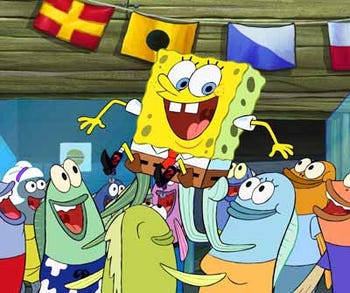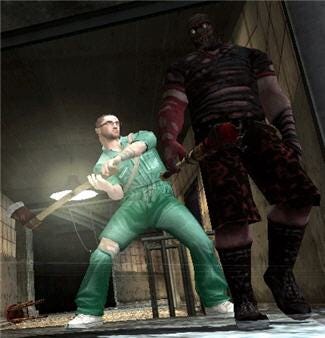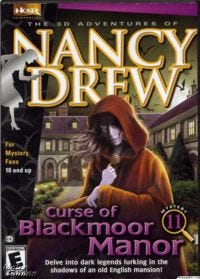Trending
Opinion: How will Project 2025 impact game developers?
The Heritage Foundation's manifesto for the possible next administration could do great harm to many, including large portions of the game development community.
Veteran developer Scott Nixon (SpongeBob SquarePants: Employee Of The Month), who has created kid-friendly games for over 10 years, presents a detailed, intriguing piece on the concept of 'piggybacking' - making games that "simultaneously entertain both a child player and an adult spectator... on wholly different levels"

Every once in a while a game comes along that defies the traditional age group stratification. Chess, Tetris, and Super Mario Bros. are all examples of games that can be mastered and enjoyed by players from both ends of the ontogenetic spectrum.
Realistically, however, the vast majority of games are iterative rather than revolutionary. These games tend, by virtue of either their mechanics or their storyline, to appeal only to a specific age range. Scant development resources and the limits of human ingenuity simply do not permit the bottling of lightning. However, if we rein in our expectations a little, there are ways to incrementally increase a game's target age radius, and one of these methods is Piggybacking.
Within the confines of this article, Piggybacking refers to a technique that simultaneously entertains both a child player and an adult spectator, if there is one, on wholly different levels. It allows the spectator to elevate themselves from audience member to bit player by acknowledging their existence and occasionally playing to them, as well as allowing them to play back.
If we get pedantic, the specific style of game I'm talking about is really a reverse Piggyback, one where the parent rides along in a vehicle designed first and foremost for the child. The problem with this terminology becomes apparent with a Google search, so let's just leave it at Piggybacking.

Piggybacking is an art that cartoons and movies have arguably mastered. A good example is SpongeBob SquarePants. Here is a cartoon that appeals to the very young and the post-adolescent crowd for entirely different reasons.
It has the visual appeal and wackiness to draw in the younger viewers, but it also has darker themes and adult-oriented humor to keep college kids and parents from dying of boredom.
Probably the single biggest reason there hasn't been a SpongeBob backlash on the order of, say, Barney, is that a parent can watch an episode of SpongeBob without afterwards feeling like part of their brain squooged out of their nose.
We aren't really talking about the difference between highbrow and lowbrow here -- it's all pretty much lowbrow. For instance -- in a moment taken from a SpongeBob episode -- Patrick (the dim-witted starfish) says something intelligent for once. SpongeBob gapes in amazement and exclaims, "Patrick! Your genius is showing!" Patrick, misunderstanding, turns beet red in shame and attempts to cover himself.
Granted, humor based on misunderstandings and/or nudity is hardly nuanced, but if Fawlty Towers can do it then it's probably fair to say the target audience includes those out of their teens.
Going back further, many classic cartoons often exhibited the hallmarks of Piggybacking, almost to a fault. Watching Bugs Bunny (and, to a lesser extent, Road Runner) episodes it's hard not to notice the fact that they often ooze sarcasm and spite. It's almost as if these writers and animators preferred to play to the adults, and if the kids thought it was funny, that was just a bonus.
As with most literary devices, Piggybacking is at its best when the seams do not show, which in turn can complicate classification. An almost perfect expression of this distinction in otherwise similar shows is displayed by Jim Henson and Co. The Muppet Show Piggybacks (literally), Sesame Street1 does not, and Fraggle Rock vacillates between the two.
Some games lend themselves to Piggybacking better than others, in large part because some games are inherently more fun to be an adjunct participant in than others. In general the hierarchy is consoles over computers, turn-based games over real-time and thinking games over twitch.
Many of these advantages are obvious. Consoles work better for Piggybacking because it's more comfortable and natural to watch someone playing a game from your couch than it is to sit in a desk chair peeking over their shoulder. Assuming you enjoy both genres equally, turn-based games are more engrossing for a spectator simply because they allow the breathing room needed to make a contribution.
Straight action games are usually spectator friendly only in a very limited "me-centric" way -- you watch, often cringing, leaning from side to side, all the while itching to get your hands on the controller and show whoever is playing how to do it right. As much as you want to help as a spectator, your warnings and suggestions will rarely yield any real benefits and are more likely just to frustrate the primary player.
You can't stick two half-decent Unreal Tournament players together and get one amazing player, but two sub-par logicians working together on an adventure game can easily overcome obstacles where one alone would be adrift.
This is not an indictment of the twitch genres. They are more exciting to watch for most than slower paced titles, but we aren't talking about merely watching; we are talking about ancillary participation. As a rule, the further a game veers away from skill into tactics, strategy, storytelling and/or puzzle solving, the more enjoyable it becomes for the "engaged bystander" because it offers a greater opportunity for involvement -- again, assuming you enjoy all these genres equally well.

A fair and likely question during this discussion is, "Does the parent-child gaming configuration occur frequently enough to warrant devoting development resources to it?"
In light of the negative publicity garnered by the likes of Manhunt 2 and GTA, there are few parents today who aren't curious about the content of games their children play beyond what scant information is available on an advisory sticker, so at the very least I'd say the inclination exists.
But even if the answer to this question is a resounding "yes", a likely follow up would be, "Does targeting parents as an adjunct in children's games translate into better sales?" After all, just because a parent is interested in what their kids are playing doesn't mean they are going to get invested themselves.
This is a nebulous area to track, and hard data simply do not exist (to my knowledge) at this point. Common sense points towards a second, although less emphatic, "yes", but even eking out a timid "perhaps" means immediately we are negotiating time vs. return, so figuring out a way to minimize investment and maximize results seems a prudent thing to do.
When discussing the methods of creating a Piggyback game, I'm going to focus on the ancillary (spectator) vector, as this is the defining feature of Piggybacking -- it's what makes the difference between a game that is agony for a parent to sit through (regardless of whether or not the child has the time of their life) and one that is innocuous or even mildly amusing.
There seem to be three broad methods, not including permutations, which are both efficacious and practical for designing a title that encourages parent-child gaming. You can either employ window dressing (and while that term may seem pejorative I don't intend it that way), wrangle mom and dad in with brute force, or level the playing field, making a game that manages to transcend age completely.
The first and most common method, window dressing, is the gaming equivalent of piping ESPN into Baby Gap. It was something I was shooting for when writing SpongeBob SquarePants: Employee of the Month a few years ago.
The puzzles and gameplay were generally designed with an age range of 6-10 years old in mind, but some of the humor was specifically aimed at parents -- for example, at one point in the game SpongeBob runs into a fish transplanted to the Pacific Ocean from the English Channel. She is unaccustomed to the climate and gripes, "It's not the heat that gets me, it's the salinity." Whether this pun elicits a giggle or a groan is certainly debatable, but the point is that while a child wouldn't likely get it, a parent probably would.
It isn't difficult to pepper your design with sight gags or one-liners that suit this purpose and, within reason (as long as they are peripheral to the plot, because you cannot count on them being absorbed by the player), the more the merrier -- although it is worth mentioning that it only takes a few laugh out loud moments for a game to be considered funny. This credo assumes that the subject matter of every Piggyback game is comedic, or at least light-hearted. This is not wholly accurate, but the nature of the beast is such that even if the game itself is not strictly a comedy, interstitial jokes won't usually seem out of place.
Another hitch you have to get used to when using this method is the less than favorable hit/miss ratio. Many writers would like nothing more than to strap gamers to a table and force them to listen to every line of their dialogue while they cackle in the corner with Kubrickian glee. It's frustrating to labor over a line knowing it's something that only a small percentage of players will hear, see, or -- the most elusive element to quantify -- get. This is a difficult enough process in a game aimed at one demographic; if you try and hit two disparate age groups you are immediately splitting the hit/miss ratio of every joke or dramatic moment in half.
In practice, window dressing is a safe method of adding another layer to a children's game. Even if many of your gags backfire you aren't really hurting anything. It doesn't typically interfere with any other aspects of design and, as such, can be tweaked late in the development cycle. As long as you aren't overly possessive of your ideas and don't mind a fair percentage of them being lost in translation, it's also relatively painless to do.

The brute force method consists essentially of designing puzzles difficult enough that kids will be forced to enlist the help of their parents to complete them. Occasionally this may pop up inadvertently as the result of unrefined game design, but more often its appearance is intentional.
The phenomenally popular Her Interactive series of Nancy Drew games is a case, I am certain, of the latter. These are highly polished games that are very well designed, but the simplicity of their plots and dialogue often belie the complexity of the puzzles they contain. Try playing The Curse of Blackmoor Manor without consulting a walkthrough and I'm sure you'll see what I mean.
This practice is more acceptable today in part because, in PC development at least, it is fast becoming safe to assume that your audience has readily available internet access. I am continually amazed by the fact that a full walkthrough for each installment of the Agatha Christie trilogy I've worked on has been available within 24 hours of each game's release.
This new set of consumer expectations may turn a game-stopping design blunder into little more than a momentary annoyance, but does not exculpate developers from doing all they can to ensure that the situation doesn't arise in the first place.
Unfortunately, the problem that emerges even among the most dedicated and experienced designer is one of accurately measuring a quality that is inherently indefinable. Even if you were designing a game with one specific child in mind, it would be impossible to discern exactly how difficult a given puzzle should be to test that child's reason to its limit without crossing the line into the realm of the unreasonable.
All the same, making games for kids that intentionally require parental assistance unfavorably recalls school science fairs comprised of projects whose juvenile involvement included little more than carrying the blasted things to class. So while you can be a little daring in erring on the side of puzzle complexity, ratcheting up difficulty to milk a few more hours of gameplay out of a sparsely interactive title is hardly the high road -- as always, games should be judged less on how many hours they take to complete and more on how many hours you actually enjoyed playing them.
The third and most desirable method, leveling the playing field, is also the most difficult to do. It is achieved by employing mechanics that nullify the reflexes of the young and subvert the wisdom of the old. This is not to say that some people aren't going to be better at this type of game than others, just that the relative performance graph would not correlate directly with age. Ideally this leaves the player to fend with nothing more than reason, an attribute that develops early and plateaus.
Full Throttle, a game released in 1995 by LucasArts, contains several puzzles that appeal to logic over experience. For example: you come to an unlocked roll-top door in a high wall, which can be raised by pulling on an adjacent hanging chain. The objective is to get to the other side of the wall. Common sense dictates the solution has something to do with pulling the chain, but this doesn't work because passing through the door necessitates letting go of the chain, and releasing the chain sends the door crashing immediately shut. The solution is to lock the garage door -- thus fixing the chain in place -- and then use the chain to climb over the wall.
You don't need to know how doors or pulleys work beforehand to figure this puzzle out. In fact, you don't need to know anything beforehand -- all information required to solve the puzzle is presented by or can be learned within the puzzle itself.
Many adventure games take this premise to its limit, abandoning much of natural law by creating worlds very different from our own, forcing you to reject many fundamental preconceptions and learn arbitrary ones. This type of worldcrafting, while time consuming and difficult for the designer, is perfect for Piggybacking. It may even tip the balance against mom and dad, whose world experience could conceivably work against them.

LucasArts' classic PC adventure game, Full Throttle
All of the methods described above can work as long as a modicum of care is employed during implementation. Counterintuitive as it may seem, simplicity does not come easy. It's quite difficult to pull off, and even more difficult to pull off well. It's far more challenging to convey relatively complex GUI or story elements with short and concise sentences than to go on some pretentious long-winded rant about, say, gaming across the generation gap. The urge to use the word "jejune" can be surprisingly overwhelming at times2.
Having originally come from the art side of production, writing for children's games fascinates me in much the same way as modeling a character or an object within a strict polygon limit -- at some stage of self-critique you become the judge and jury in a trial for each polygon's continued existence. You have to objectively trim and rework without mercy. What polygons ultimately remain must be justified and exploited to their full potential. Just swap "polygons" for "words" and it's an accurate analogue. Every word matters. It's certainly worth investing the time and money it takes to make sure it's done right.
Tragically, when writing about the games business, many paragraphs begin with adverbs like "tragically", and many publishers and developers skimp on writers when it comes to creating children's games.
Even worse, many writers skimp on writing when working on children's games -- an opportunity squandered. It might not be such an issue if you aren't concerned with appeasing the adult spectator role, but if a good work ethic isn't enough to disavow you of this notion, it's a good idea to remember who possesses the buying power in the parent-child relationship. While your primary target demographic may not notice shoddy wordsmithing, your secondary one probably will.
So the next time you find yourself designing a children's title, remember there may be a literate and highly critical parent watching and judging your every move. You may not have the time or resources to level the playing field, so avoid condescension, encourage lateral thinking, and throw in an occasional bone for the old-timers. Not only will you expand your audience, it's just possible the result will create a lasting memory as a bonding experience between family members.
1 Coincidentally, the New York Times recently covered how Sesame Street originated as a Piggyback show (albeit not in those words), but has become increasingly puerile over the years - to the point where the upcoming release of season one on DVD carries the following disclaimer: "These early 'Sesame Street' episodes are intended for grown-ups, and may not suit the needs of today's preschool child."
2 Ask Woody Allen.
Read more about:
FeaturesYou May Also Like